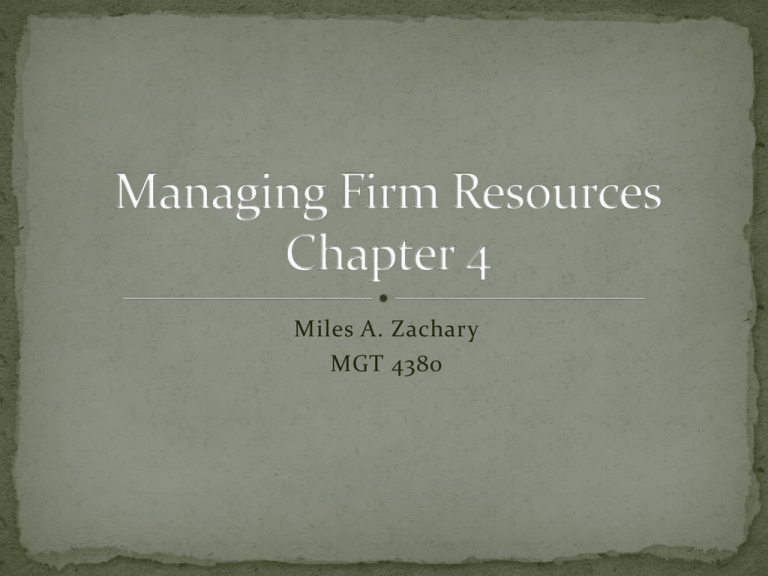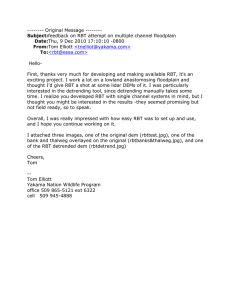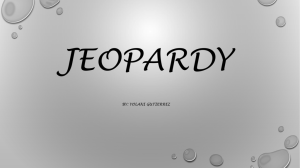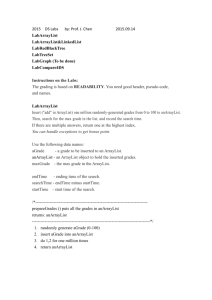Chapter 4 MAZ
advertisement

Miles A. Zachary MGT 4380 Discuss Exam 1 Lecture RBT Intellectual Property Value Chain Alternative Theories in Strategy SWOT Analysis SWOT Exercise Simulation Resource-based theory (RBT) suggests that firms that possess strategic resources have a greater chance of developing a competitive advantage over competitors and in turn, higher profitability A strategic resources is an asset that is: Difficult to imitate Rare Valuable Non-substitutable Difficult to imitate-competitors have a hard time duplicating the resource Rare-the resource is difficult to cultivate or find in the industry Valuable-a resource that helps a firm create strategies that capitalize on opportunities and ward off threats Non-substitutable-competitors are unable to find an alternative way to enjoy the benefits provided by a particular resource Additionally, some firms are able to bundle strategic and non-strategic (generic) resources together Firms able to combine multiple resources are often able to create a unique business model that puts the firm far ahead of its competitors Ex. Southwest Airlines: Combined their unique corporate culture (a strategic resource) with other generic (yet valuable) resources such as direct flights, low fares, one-plane fleet, and unique passenger boarding to create an effective and efficient competitive advantage Firms in possession of strategic resources that meet the four criteria of RBT are often in a position to gain a sustained competitive advantage A sustained competitive advantage is one that will endure over time and will help the firm remain successful well into the future While anyone of the qualities is good, possessing a resources with fewer than all four will likely lead to only a temporary advantage On occasion, the external environment can turn a generic resource into a strategic resource Resources are goods and services owned by an organization Tangible Resources-resources readily seen, touched, and quantified; often physical objects or places Eg., a firm’s property, plant, and equipment, cash Intangible Resources-resources difficult to see, touch, or be quantified Eg., knowledge and skills, organizational culture, firm reputation Capabilities refer to the firm’s ability to bundle, manage, or otherwise exploit resources such that value is added and a competitive advantage results More generally, capabilities are what a firm can do with their resources Capabilities tend to arise over time Dynamic capabilities are the ability to create new and better capabilities Adaptive firms use dynamic capabilities to stay up or ahead of the every-changing environment Ex. Coca-Cola-has a knack for being an excellent brand builder While resources and capabilities are determinants of firm performance, customers must often be convinced to purchase the resulting goods and services The marketing mix (or 4 Ps) helps firms do that by providing a strong alignment among: Product-what a firm sells Price-what it sells it for Place-where it sells it Promotion-how a firm communicates these things Intellectual property refers to creations of the mind (e.g., inventions, artistic products, symbols, etc.) Four main types of intellectual property include: Patents Trademarks Copyrights Trade Secrets Intellectual property resources are strategic resources when they fit the RBT criteria Even IP resources that have only some of the RBT criteria can be bundled with other resources Can be protected by formal and/or informal methods Patents-legal decrees that protect inventions from direct imitation for a limited period of time Difficult to get; must be new, non-obvious, and useful Patents are core advantages in many industries Trademarks-protected phrases, pictures, names, or symbols used to identify an organization Help an organization stand out and build an identity in the marketplace Other firms use trademarks to carve out niche positions Copyrights-provide exclusive rights to the creators of artistic works (e.g., books, movies, songs, etc.) Pirated material violates copyright material Trade Secrets-formulas, practices, and designs that are central to a firm’s business, but remain unknown to competitors Ex.-KFC’s secret spice blend, the formula for WD-40, the recipe for Coca-Cola The copying of trade secrets is legally protected; however, once a secret is revealed, it is legally a secret no longer The value chain charts the path by which products and services are created and eventually sold to customers; firm specific Organizations need to consider their resources and capabilities alongside the value chain when formulating and implementing strategies Composed of two sets of activities Primary Activities Secondary Activities A supply chain is a system of people, activities, information, and resources involved in creating a product and moving it to the customer The supply chain is a broader concept that captures the entire process of creating and distributing a product, often times across different firms Best value supply chains combine the concept of the supply chain with the considerations of the valuecreation process within a firm Like other multi-metric performance assessments, BVSCs focus on total value added, specifically to customers Four components: Strategic supply chain management Agility Adaptability Alignment Using a supply chain to create competitive advantages and enhance performance Strategic SC use is measured by: Speed-time from initiation to completion of the production and distribution process Quality-relative reliability of SC processes Cost-enhance value by reducing expenses Flexibility-refers to the responsiveness of the supply chain to changes in customer needs The supply chain’s relative capacity to act rapidly in response to changes in supply and demand Agility can be achieved by using buffers Excess capacity Technical information systems Co-locating with customers can provided important face-to-face interaction Adaptability is the willingness and capacity to reshape supply chains when necessary While one supply chain is desired since it is cost effective, it is not always the best value solution Having a variety of options increases adaptability Alignment refers to creating consistency in the interests of all participants in a supply chain When situations arise that pit the interests of one party and the whole supply chain against each other, conflict ensues Maintaining alignment is necessary to keep the supply chain operating with maximum efficiency Carefully writing incentives, collaborating on forecasting, and meeting with participants can improve supply chain alignment Enactment-firms can create and manipulate their own environment through outstanding strategy Environmental determinism-a firm’s environment is a dominating force that determines the fate of the organization Institutional theory-suggests that firms are bound by social pressures that result in imitation of strategies Transaction cost economics-firms determine whether to make or buy the products/services they need based on transaction costs SWOT analysis is a simple tool firms can use to evaluate their internal strengths and weaknesses and external opportunities and threats when determining strategic decisions Internal and external factors should not be confused with each other Opportunities should not be confused with strategic moves to capitalize on opportunities The simplicity of the analysis suggests that it should not be over-evaluated











